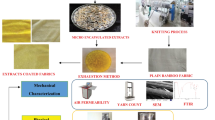Abstract
Modern wound dressings are expensive for the majority of the people of 3rd world countries. There is a possibility to design and develop a proper and low-cost dressing that will have the properties of modern wound dressing. The aim of this research work is to develop a low-cost wound dressing with the properties of an antibacterial, absorbent, non-adherent, and capable to maintain a moist environment around the wound. The commercial antiseptics Dettol and Savlon were applied with different concentrations and M: L ratios on the cotton gauze fabric by pad dry method and the ZOI (zone of inhibition) was evaluated against E. coli. The antibacterial behavior exhibits even after one year. An absorbent layer of cotton fabrics, cotton fiber, and viscous fiber are used to assess their ability to absorb liquid. The absorbency and retention value of the absorbing layers were evaluated in g/g and g/cm2. In a non-adherent layer, the gauze fabric was dip-coated using PVA (poly (vinyl alcohol)) polymer solution using a padding mangle. The peel-off force of PVA-coated fabrics was measured using a gelatin wound exudates model and UTM (universal testing machine). The obtained antibacterial and absorbency results were compared with commercial wound dressing and have shown promising results. The PVA-coated fabric was non-adherent to the wound and maintain a moist environment on the wound surface. So, the developed PVA-coated antibacterial wound dressing with cotton fiber absorbent layer can be used as an alternative to branded wound dressing for the poor people of third world countries.
















Similar content being viewed by others
References
G.S. Lazarus, D.M. Cooper, D.R. Knighton, D.J. Margolis, R.E. Percoraro, G. Rodeheaver, M.C. Robson, Wound Repair Regen. 2, 165 (1994)
T. Velnar, T. Bailey, V. Smrkolj, J. Int. Med. Res. 37, 1528 (2009)
S. Dhivya, V.V. Padma, E. Santhini, Biomed. 5, 24 (2015)
Y. Liu, T. Li, Y. Han, F. Li, Y. Liu, Curr. Opin. Biomed. Eng. 17, 100247 (2021)
E. Rezvani Ghomi, S. Khalili, S. Nouri Khorasani, R. Esmaeely Neisiany, S. Ramakrishna, J. Appl. Polym. Sci. 136, 47738 (2019)
S. Jirawitchalert, S. Mitaim, C.-Y. Chen, N. Patikarnmonthon, Int. J. Biomater. 2022, 1–12 (2022)
E.B. Tpyшкин, H.B. Ceнявинa, ДA. Caxapoв, A.Л Pycaнoв, У Mapкc, A.Г Toнeвицкий, Биoтexнoлoгия 1, 51 (2013)
J. Fong, F. Wood, Int. J. Nanomedicine 1, 441 (2006)
A. Bal-öztürk, B. Özkahraman, E. Tamahkar, E. Alarçin, J. Biomed. Mater. Res. Part B Appl. Biomater. 109, 703 (2020)
S.R. Nussbaum, M.J. Carter, C.E. Fife, J. DaVanzo, R. Haught, M. Nusgart, D. Cartwright, Value Heal. 21, 27 (2018)
G. Schultz, G.T.K. Harding, K. Carville, P.N. Chadwick, Z.E.H. Moore, M. Marguerite, P. Steven, Wounds Int. (2019).
J.P.E. Junker, R.A. Kamel, E.J. Caterson, E. Eriksson, Adv. Wound Care 2, 348 (2013)
L.J. Borda, F.E. Macquhae, R.S. Kirsner, Curr. Dermatol. Rep. 5, 287 (2016)
M. Waring, S. Bielfeldt, M. Brandt, Wounds 5(3), 22–31 (2009)
K.P. Chellamani, D. Veerasubramanian, R.S.V. Balaji, J. Acad. Indus. Res. 1, 778 (2013)
E.H. Portella, D. Romanzini, C.C. Angrizani, S.C. Amico, A.J. Zattera, Mater. Res. 19, 542 (2016)
M. Miraftab, A.N. Saifullah, A. Çay, J. Mater. Sci. 50, 1943 (2015)
ASTM-E2922, ASTM Int. 1 (2015).
C. He, X. Liu, Z. Zhou, N. Liu, X. Ning, Y. Miao, Y. Long, T. Wu, X. Leng, Mater. Sci. Eng. C 128, 112342 (2021)
A.M. West, P.J. Teska, C.B. Lineback, H.F. Oliver, Antimicrob. Resist. Infect. Control 7, 1 (2018)
S.M. Shang, in Process Control, in Textile Manufacturing. ed. by A. Majumdar, A. Das, R. Alagirusamy, V.K. Kothari (Woodhead Publishing Limited, Cambridge, 2012), pp.300–338
P. Szweda, G. Gorczyca, R. Tylingo, J. Wound Care 27, 320 (2018)
C.E. Bradshaw, Biosci. Horizons 4, 61 (2011)
S. Rajendran, S.C. Anand, J. Wound Care 11, 191 (2002)
S.M. Lee, I.K. Park, Y.S. Kim, H.J. Kim, H. Moon, S. Mueller, H. Arumugam, Y.I.L. Jeong, Biomater. Res. 20, 1 (2016)
M. Stankovská, J. Gigac, M. Fišerová, E. Opálená, Wood Res. 64, 261 (2019)
M.A. Rousselle, D.P. Thibodeaux, A.D. French, Text. Res. J. 75, 177 (2005)
P.D. Dubrovski, M. Brezocnik, Fibers Polym. 17, 801 (2016)
K.D. Park, X. Wang, J.Y. Lee, K.M. Park, S.M. Zhang, I. Noh, Biomater. Res. 20, 1 (2016)
R. Dhiman, R. Chattopadhyay, J. Text. Inst. 112, 996 (2021)
A. Nazir, T. Hussain, F. Ahmad, S. Faheem, Autex. Res. J. 14, 39 (2014)
M.M. Kamel, H.M. Helmy, H.M. Meshaly, A. Abou-Okeil, J. Text. Sci. Eng. 05 (2015)
S. Shyna, A.S. Krishna, P.D. Nair, L.V. Thomas, Int. J. Biol. Macromol. 150, 129 (2020)
S. Cichosz, A. Masek, Mater. Basel. 13, 1 (2020)
X. Zhang, FTIR spectrum analysis tool (Xin’s page at website of University of Maryland, College Park, 2022)
M.T. Khorasani, A. Joorabloo, A. Moghaddam, H. Shamsi, Z. MansooriMoghadam, Int. J. Biol. Macromol. 114, 1203 (2018)
Funding
This study received no specific fund from any agency.
Author information
Authors and Affiliations
Corresponding author
Ethics declarations
Competing interests
The authors declare that no competing interests exist.
Additional information
Publisher's Note
Springer Nature remains neutral with regard to jurisdictional claims in published maps and institutional affiliations.
Rights and permissions
Springer Nature or its licensor (e.g. a society or other partner) holds exclusive rights to this article under a publishing agreement with the author(s) or other rightsholder(s); author self-archiving of the accepted manuscript version of this article is solely governed by the terms of such publishing agreement and applicable law.
About this article
Cite this article
Ghosh, S., Balasubramaniam, K. & Das, P. Design and Development of Wound Dressing by Using Commercial Antiseptic Liquid. J. Inst. Eng. India Ser. E 104, 51–60 (2023). https://doi.org/10.1007/s40034-022-00256-2
Received:
Accepted:
Published:
Issue Date:
DOI: https://doi.org/10.1007/s40034-022-00256-2




